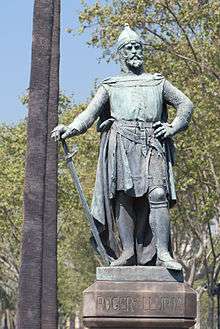Roger of Lauria
| Ruggerio di Lauria i d'Amichi | |
|---|---|
 Statue of Roger of Lauria in Barcelona | |
| Born |
1245 Lauria or Scalea |
| Died |
January 19, 1305 Valencia, Kingdom of Valencia |
| Allegiance |
|
| Years of service | 1283-1302 |
| Rank | Admiral |
| Battles/wars | War of the Sicilian Vespers |
Roger of Lauria (c. 1245 – 17 January 1305), was a Sicilian admiral in Aragonese service, who was the commander of the fleet of Aragon during the War of the Sicilian Vespers. He was probably the most successful and talented naval tactician of the medieval period. He is known as Ruggero or Ruggiero di Lauria in Italian and Roger de Llúria in Catalan.
Biography
Roger of Lauria was born at Lauria or Scalea in southern Italy, the son of Richard of Lauria, Great Justiciar of the Kingdom of Sicily, and Donna Bella, a nurse of Constance of Sicily. His father had served under King Manfred of Sicily; when the last member of that family, Conradin of Swabia, was beheaded at Naples in 1268, he took refuge with other Ghibelline exiles at Barcelona (Principality of Catalonia), part of the Crown of Aragón with his mother.
Later King Peter III of Aragon, who had married Constance of Hohenstaufen, made him knight together with Corrado Lancia, who was to be a comrade of Roger in many of his enterprises. In 1282 Roger was named commander of the Aragonese fleet, keeping this charge under Peter's successors James II and Frederick III.
Roger of Lauria commanded the Aragonese fleet during the campaign to capture Sicily from the Angevins after the Sicilian Vespers revolt in 1282, which made the Aragonese rulers of Sicily. He fought and won six naval galley battles in total. On 8 July 1283 (Battle of Malta) he defeated the Angevins in the Grand Harbour of Malta. On 5 June 1284 (Battle of Castellammare), he defeated the Neapolitan fleet and even captured the enemy commander, Charles of Salerno (the future Charles II of Naples).
On 4 September 1285 (Battle of Les Formigues) during the Aragonese Crusade, he defeated the French near Barcelona, which destroyed for a long time the French naval power in the Mediterranean. Within days, he had landed and took part in the Battle of the Col de Panissars. On 23 June 1287 (Battle of the Counts) he again defeated the Angevins near Naples, despite his fleet consisting of only forty ships against the enemys' eighty. After this victory, without any authorisation from King James, he made a truce with the Neapolitans. Observers noted that this truce probably deprived the Aragonese-Sicilians of the victory also on the mainland.
When Frederick III was elected King of Trinacria (Sicily), Roger received as reward for his victories the fief of Aci and the annexed castle, stripped from the bishops of Catania. However, the relationship between the admiral and the young King soon soured; when the former passed to the Angevins, Aci was besieged and captured by Frederick, and Roger took refuge at his summer residence in Castiglione di Sicilia. Again besieged and defeated, he was arrested and brought to Palermo. However he managed to escape and left Sicily, while all his fiefs were confiscated. Roger therefore passed to the service of Edward I of England, to fight against the French. But, in spite of his promises, he returned to Italy, where, on 4 July 1299 (Battle of Cape Orlando), he defeated the Sicilians near Sicily, capturing eighteen enemy galleys.
He had another victory on 14 June 1300 (Battle of Ponza), in which he defeated and captured king Frederick himself. After the Peace of Caltabellotta, he submitted to Frederick and received a whole pardon. He retreated to Cocentaina in the Kingdom of Valencia, where he died in 1305.
Tactics
Roger was successful in naval warfare because of several skillful tactics. He tried to lure enemy fleets out of defended ports, pretending to retreat and getting them to chase him until they became disorganized, then turning in formation to attack. He had much more control over his captains than the enemies did. His crews were made up of specialized troops, instead of the more generic types used by his enemies. His archers were used initially, while his oarsmen and/or Almogavars (unarmored and highly mobile elite troops armed with two javelins, a lance and a dagger) stayed under cover. When the galleys closed, often from the sides of the enemy galleys (which damaged their oars), these skirmishers were much more agile than the heavily armored knights with swords his enemies often used, especially on the moving deck of a galley at sea. He used trickery to disguise the size of his force. In addition, he sometimes kept some of his galleys hidden, to attack the rear of the enemy after the battle had started.
Roger was also infamous for the ruthless sackings and the devastations of his actions, often driven only by greed and personal advantage. On the other side, his reputation alone possibly caused some enemies to lose heart during a battle.
Namesakes
The Regia Marina (Royal Navy) battleship Ruggiero di Lauria, completed in 1888 and stricken in 1909, was named for Roger of Lauria.
One of the main paratrooper units of the Spanish airborne forces is named after him.
References
- The Columbia Electronic Encyclopedia (2003) "Roger of Loria". Columbia University Press.
- Roger de Lauria at the Classic Encyclopedia, based on the 1911 Edition of the Encyclopædia Britannica
- (Catalan) (ISBN 978-84-931820-6-9) Roger de Llúria - Infiesta Pérez, José Luis Infiesta, Editor - col·lecció Gent nostra
|